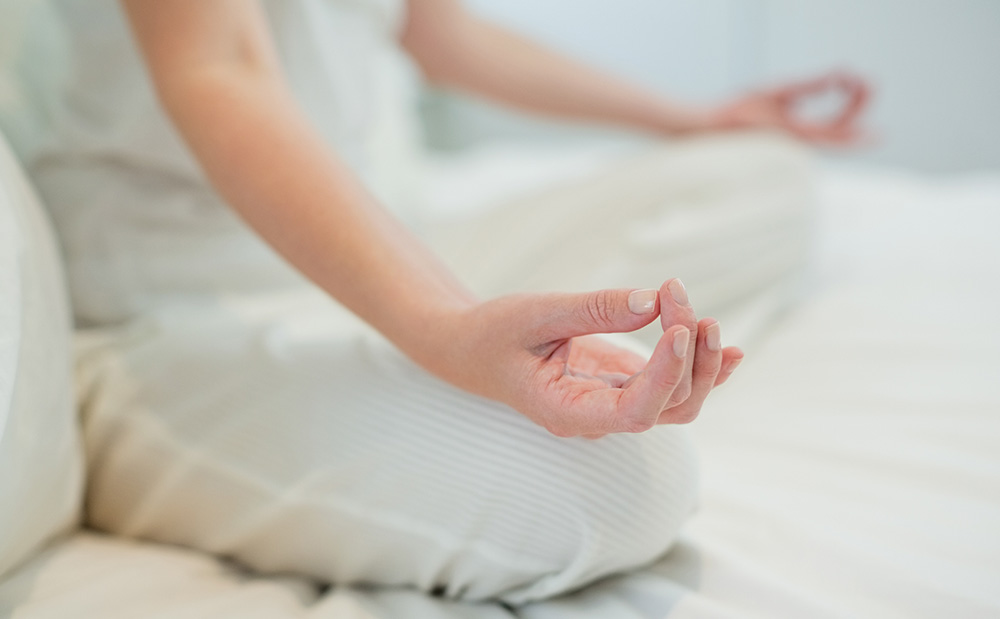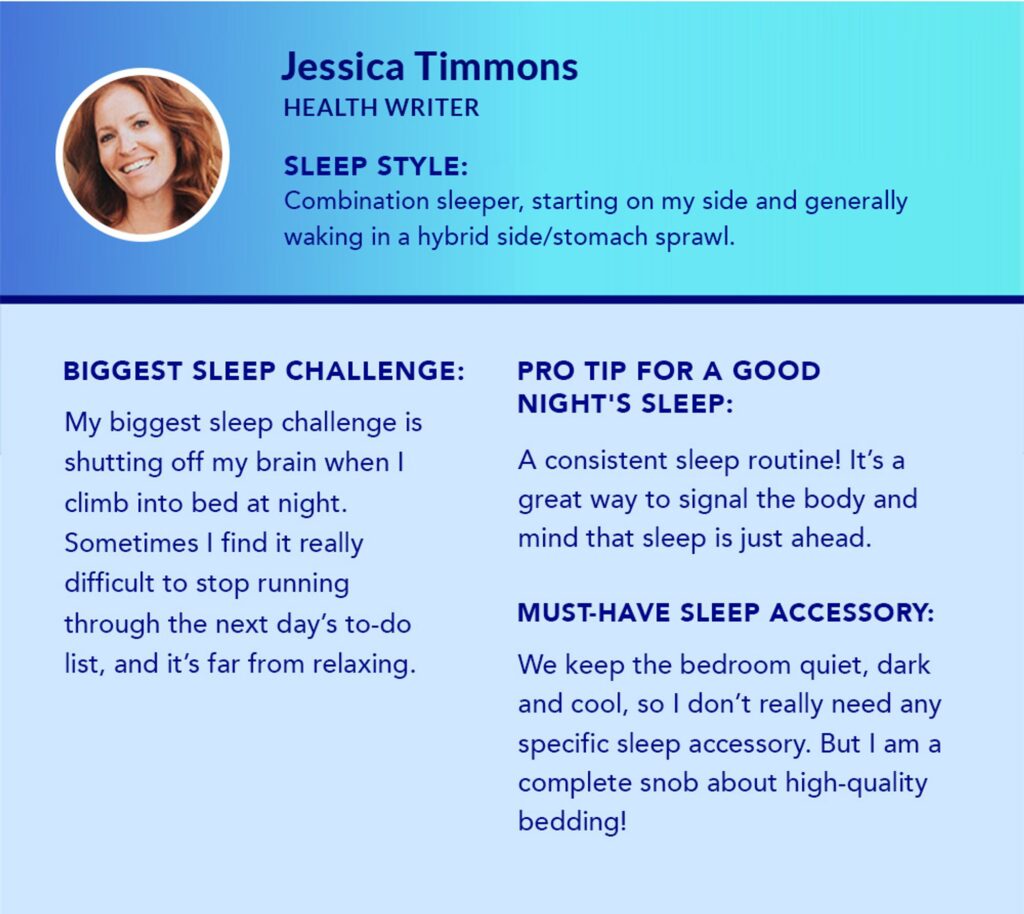
Mindful breathwork can help bring the body and mind into a state of relaxation, which is exactly what you want when you’re ready to go to sleep. By focusing on and following specific patterns of inhaling, holding the breath, and then exhaling, it’s possible to ease stress and promote relaxation. The 4-7-8 breathing technique is one such pattern and according to Samantha Bender, LCSW-S, a therapist who specializes in sleep, it offers myriad benefits for sleeping, soothing, and reducing anxiety. To understand those benefits, I tried the 4-7-8 breathing technique before bed every night for one week. Here’s what I learned.
Note: The content on Sleepopolis is meant to be informative in nature, but it shouldn’t be taken as medical advice, and it shouldn’t take the place of medical advice and supervision from a trained professional. If you feel you may be suffering from any sleep disorder or medical condition, please see your healthcare provider immediately.
Long Story Short
- The 4-7-8 breathing technique follows a pattern of breathing that helps slow the heart rate and lower blood pressure, which can set you up for sleep.
- The process of breathing in for a count of four, holding for a count of seven, and exhaling for a count of eight, repeated four times, may help bring your attention inward and away from distractions.
- When I used this breathing pattern every night for seven days before bed, I found it surprisingly effective — particularly for combatting stress responses — once I found my rhythm.
What Is the 4-7-8 Breathing Technique?
The clue is in the name. “The 4-7-8 breathing technique is a type of breathwork that follows a pattern of breathing in through the nose for four seconds, holding the breath for seven seconds, and fully exhaling through the mouth for eight seconds,” Bender tells Sleepopolis.
Bender recommends the technique to her clients when they’re experiencing significant levels of stress and need help calming down or reconnecting with their bodies. “Stress affects our body and our thoughts, which can negatively impact rest and sleep,” she adds.
How to Use the 4-7-8 Technique for Sleep
Using the 4-7-8 technique at bedtime can be particularly helpful if you find yourself in a state of sleeplessness because you can’t power down your brain. By focusing your attention away from what’s worrying you to the timed repetition of the 4-7-8 breathing technique, you may be able to actively calm your body and mind — according to a 2023 meta-analysis, deliberate control of the breath might be an effective way to improve both stress and mental health (1).
“The act of deep breathing slows the heart rate and helps your nervous system enter a parasympathetic state, the part of the nervous system that controls rest and relaxation,” Dr. Chelsie Rohrscheib, head sleep expert and neuroscientist at Wesper, tells Sleepopolis. By switching into the parasympathetic state, she explains, deep breathing can help prevent sympathetic nervous system activity, a state that promotes stress and wakefulness—something you don’t want when you’re trying to fall asleep.
This kind of deep breathing exercise promotes better sleep by reducing the stress response, adds Rohrscheib. That’s key, she says, because your brain and body should both be very relaxed and stress-free before and during sleep.
Rohrscheib cautions that deep breathing takes practice, and it can take several days to weeks before you notice an improvement in your sleep quality. “For best results, deep breathing should be combined with good sleep hygiene habits,” she says. “Deep breathing alone may not be sufficient for people with certain sleep disorders and medical conditions.”
My Experience Using the 4-7-8 Technique for Sleep

On the whole, I would describe my sleep quality as good. We have four kids and weekdays start at 6 a.m., so we’re in bed no later than 9 p.m. I follow the same bedtime routine (brushing my teeth, washing my face, applying serums and lotions, all that good stuff) every single night. We turn down the thermostat, turn off all the lights and live in a quiet neighborhood, so it’s reliably cool, dark and quiet.
But occasionally, I find myself laying in bed and running through lengthy to-do’s, from deadlines to mental reminders, far longer than I would like. On nights like these, I usually just do my best to distract myself by focusing on relaxing my body from my toes upward. It feels nice, but sometimes I finish up and my brain immediately jumps back to all the things I need to do tomorrow right. As an alternative, I committed to using the 4-7-8 technique for seven straight nights.
On night one, I climbed into bed, got comfortably settled on my back, and inhaled for a count of four. While I understand the pattern—four seconds, seven seconds, eight seconds—I didn’t account for the amount of air I would need to inhale to make it through holding for seven seconds and exhaling for eight. It was a novice mistake, something that became very clear very quickly, when I struggled to exhale for a full eight seconds. It was the opposite of relaxing. Squeezing my abs hard to expel enough air through the full eight seconds actually elevated my heart rate slightly. It seemed like an ominous sign!
On round two, I was much more prepared and inhaled deeply for the first four seconds, held for seven, and exhaled slowly for eight. Once I was into this rhythm, the next two rounds of breath were much easier. And while I did find myself distracted from my usual mental to-do while I counted and focused on breathing, it didn’t seem like I fell asleep any faster than usual.
I noticed a big improvement on nights two and three. I was much more comfortable with the pattern itself and moved easily through my four rounds. I have no recollection of anything after this breathwork, so I must have fallen asleep quickly. The same is true of nights four through six.
I was particularly impressed on night five, when my family of six stayed up later than usual for movie night. I was a little wired when we finally got to bed, in that physically-tired-but-too-amped-to-sleep way (I blame the later bedtime), and I was interested to see how well this technique would fare. Again, I don’t remember laying in bed awake and frustrated, so it appears to have done the trick!
On night seven, a Sunday, I wasn’t particularly tired at bedtime, thanks to sleeping in a little later than usual that morning. This is when the 4-7-8 technique didn’t seem to work its usual magic, likely because I wasn’t trying to address a stress response. I tried the technique several times over the course of about an hour in an effort to physically and mentally relax, but I probably would have been better off reading until I was tired enough to nod off.
Going forward, I plan on using the 4-7-8 technique on nights when I’m having a hard time slowing my brain down.
FAQs
Can the 4-7-8 breathing method help with blood pressure?
“Because blood pressure is regulated by the nervous system, breathing methods like the 4-7-8 breathing method may lower blood pressure,” says Bender. “These benefits are especially apparent when deep breathing is practiced daily.” That’s backed up by recent research, which found that the 4-7-8 breathing method can help improve blood pressure (2).
How many times should I do the 4-7-8 breathing technique for it to be effective?
It may vary from one person to the next, but Bender says the general recommendation for practicing this technique is four rounds. “Calming effects may be felt after just one round of 4-7-8 breathing,” she adds.
The Last Word From Sleepopolis
If stress and anxiety keep you from relaxing enough to fall asleep, the 4-7-8 breathing method is worth a try. It’s easy to learn, quick to execute, and effectively calms the body and slows the heart rate. There’s a slight learning curve for beginners, and it’s not uncommon to feel a little light-headed at first. But practicing this breathing technique in bed could be the key to unwinding enough to drift off.
Sources
Bender, Samantha. (February 2024). Personal interview.
Rohrscheib, Chelsie. (February 2024). Personal interview.
- Fincham GW, Strauss C, Montero-Marin J, Cavanagh K. Effect of breathwork on stress and mental health: A meta-analysis of randomised-controlled trials. Sci Rep. 2023 Jan 9;13(1):432. doi: 10.1038/s41598-022-27247-y. PMID: 36624160; PMCID: PMC9828383.
- Vierra J, Boonla O, Prasertsri P. Effects of sleep deprivation and 4-7-8 breathing control on heart rate variability, blood pressure, blood glucose, and endothelial function in healthy young adults. Physiol Rep. 2022 Jul;10(13):e15389. doi: 10.14814/phy2.15389. PMID: 35822447; PMCID: PMC9277512.



























